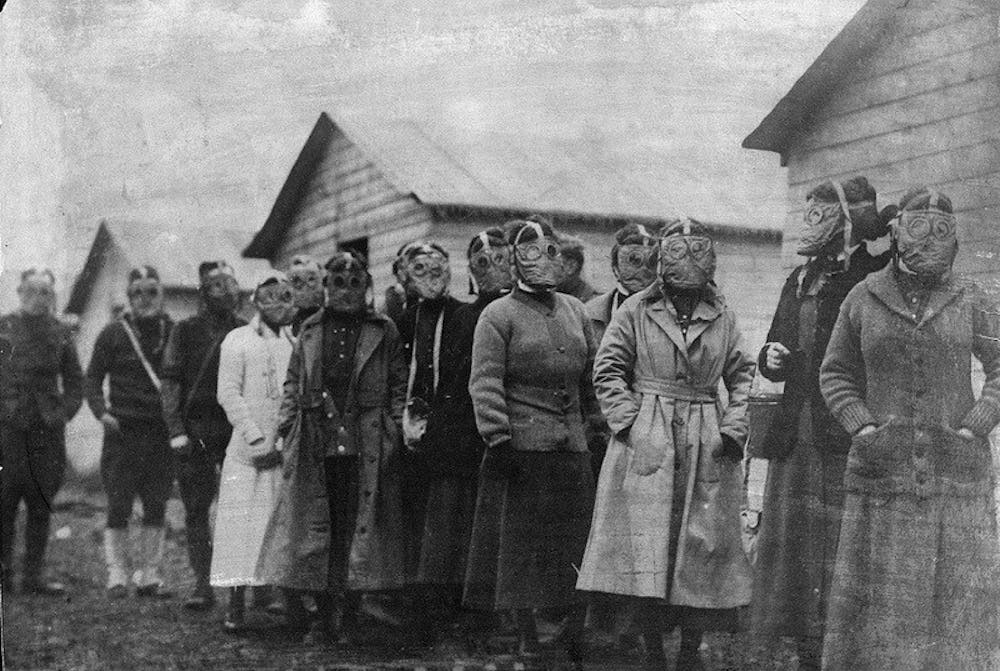Imagine Homewood Campus one hundred years ago, as Europe was torn asunder by the First World War and American students and medical staff sailed to Europe to treat the wounded.
Hopkins and the Great War examines how World War I affected Hopkins students, staff and medical professionals. This exhibition includes two visual displays at Homewood, installations at the School of Nursing and the School of Medicine and an extensive online digital archive. This exhibition includes personal items, photographs, propaganda posters, official documents and medical tools from Hopkins affiliates who experienced the Great War.
On the Homewood Campus, Hopkins and the Great War includes two visual displays in the Milton S. Eisenhower Library on the M- and Q-levels. On Q-Level, “Representations” highlights items of war propaganda, such as posters that encouraged American nursing students to serve abroad. “Experiences,” on display on M-Level, includes documents relating to the experience of Hopkins students and alumni during the War, including letters and postcards from the front, notes from a Hopkins chemist recruited by the U.S. government and pages from The News-Letter and the Hullabaloo yearbook that reflect how students were increasingly affected by the War, even if they did not go to Europe.
The “Aftermath” section, also on M-Level features items related to the conclusion of the War and the making of a fragile, fractious peace.
Isaiah Bowman, an ardent racist, noted geographer and virulent anti-semite who served as president of the University from 1935 to 1948, was involved in the making of the Treaty of Versailles. As the Chief Territorial Specialist of the American delegation at the Paris Peace Conference, Bowman played an important role in determining new national boundaries.
Bowman’s redrawing of the political map continues to reverberate in the form of modern-day conflicts in Ukraine and on the Balkan Peninsula. On display in this exhibition are Bowman’s Paris diary, several hand-drawn maps with proposed boundaries and a collection of souvenirs from the Paris Peace Conferences.
This final section of the exhibition also reflects upon the material memories of the Great War on the Homewood Campus. The Alumni Memorial Dormitory, the first dormitory building to be constructed at Hopkins, was completed in 1923 and named after the Hopkins men lost overseas.
Buildings still on campus today, including Latrobe Hall and Maryland Hall, served as quarters for the Student Army Training Corps. Following the end of the War, the Federal Board offered disabled American veterans funded educations for Vocational Training, and at least 24 such students came to study at Hopkins in 1920.
A World War I commemorative plaque listing the names of the male Hopkins affiliates who died during the War suggests the human toll of the War on the Hopkins community, although there were also casualties among the female Hopkins nurses who served during the War, who received no similar commemoration.
Hopkins and the Great War opened with a talk by Alice Kelly, women in the humanities postdoctoral research fellow at the University of Oxford, about Ellen La Motte, a Hopkins nursing graduate who penned a graphic and frank memoir entitled The Backwash of War. The talk was sponsored by the Hopkins Retrospective, the Department of History of Science and Technology, the Department of English and the Writing Seminars, and was introduced by Jenny Kinniff of the Hopkins Retrospective. The talk allowed for new insights into the First World War from the perspective of queer and female history.

At the Johns Hopkins Medical Archives are sixteen letters between La Motte and her closest friend, Amy Wesselhoeft von Erdberg of Berlin, and these documents reveal a great deal about La Motte and her friendships and connections.
The letters describe La Motte’s life before the War with her avant-garde friends in Paris including Gertrude Stein and Henri Matisse on visits to England to meet with the suffragettes fighting valiantly for the right to vote, and managing the end of a break-up with a woman from New York. When the First World War began, La Motte volunteered her services at a number of hospitals in France and Belgium. La Motte was among hundreds from the Hopkins community who joined the effort to provide medical care to soldiers during the war to end all wars.
Kelly began her talk by reading out a scene from this memoir in which a deserter with a self-inflicted gunshot wound is transported back to a field hospital in Belgium so that he can be healed of his wounds and summarily executed. Such bloody and visceral moments characterized the memoir of La Motte, whose book was published in 1916 and soon after suppressed by the British and American governments. Kelly argued that La Motte’s memoir is unique because it was written and published during the war, whereas most of the famous memoirs of the war, including perhaps the most famous female memoir of the war, Vera Brittain’s Testament of Youth, were written and published in its aftermath. Kelly and a colleague are currently compiling a new edition of The Backwash of War, which will include new scholarly notes on the historical and literary context of the work.
Hopkins and the Great War is an especially innovative production for the Hopkins Retrospective because it features installations on the different campuses of the university and pulls from different collections of the University archives. Besides the exhibits on the M- and Q-Levels of the Milton S. Eisenhower Library on the Homewood campus, there are displays at the Anne M. Pinkard Building of the School of Nursing and at the William H. Welch Medical Library at the School of Medicine. The exhibition offer Hopkins students and staff new knowledge about this conflict and the ways in which the members of our university adapted to transformative and tragic times.





